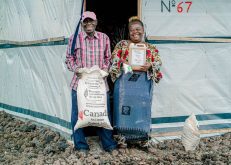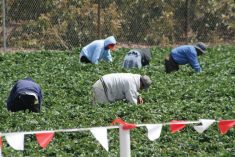Many farmers and Albertans support the Canadian Foodgrains Bank, but few have seen the impact that their donations make.
Keith and Jacilyn Goutbeck have — and won’t soon forget what they encountered on a learning tour to Ethiopia at the end of January.
The siblings visited individual families in communities that had received Foodgrains Bank support. They were invited into people’s homes — typically a mud hut measuring 6×12 feet with a cooking area out back and a small fenced-in area at the front.
“It was pretty eye opening for people to see the conditions that people were living in,” said Keith. “But they were happy to bring us in and they even offered us food, because the culture there is to really serve your guests and be grateful to them for visiting.”
“It was a huge honour for them to have us there but there’s also an overwhelming sense of community within the country,” added Jacilyn. “There’s always a welcoming atmosphere wherever you go.”

The third-generation farmers from Fort Saskatchewan have been supporting the Foodgrains Bank for most of their lives. The community’s growing project — 150 acres are provided rent free by an energy company and local businesses cover the cost of inputs — is one of nearly three dozen in the province. (Area farmers grow and harvest a crop and then donate the proceeds to the organization.)
The siblings were part of a group of 15 on the 12-day tour, visiting several Foodgrains Bank projects.
“One of them was an orphanage and a vulnerable children’s project in a remote area in the more northern part of Ethiopia,” said Jacilyn.
She explained the Foodgrains Bank doesn’t start projects itself, but helps fund (often through food-for-work support) initiatives determined by the local community. The organization is a collection of 15 church-based agencies that are working together to end world hunger. It also has food assistance and nutrition programs.
“What I was really impressed with was seeing the area and the compound where they had all these children sponsored,” said Jacilyn. “They did a really good job of making sure it was really holistic. They were there all the time, they had social workers, they had food aid where they provided rations for the families, they made sure the kids were in school, and they had supplies and everything along with medical care.
“That, to me, was very impressive.”

Keith, who farms grains and potatoes with his brother and cousin, noted the project employed quite a lot of local people as well.
“It’s pretty community oriented because the people in the area are employed to run the program,” he said.
The group also visited several farming projects including an irrigation project in a town northwest of Addis Ababa. The Foodgrains Bank helped fund a project to divert water from a local river. The 2.5-kilometre-long project was hand built and took two years to complete.
“It’s really rare to see equipment,” said Jacilyn. “The first project that we saw was all hand dug out. It had to be perfectly engineered so the water came down. It was just really impressive.”
Read Also

Farming Smarter receives financial boost from Alberta government for potato research
Farming Smarter near Lethbridge got a boost to its research equipment, thanks to the Alberta government’s increase in funding for research associations.
“The amount of work that took was hard to imagine because in general, they only had 60 to 80 people working per day,” added Keith.
Jacilyn was moved by seeing how the first crop had benefited from the irrigation project. Ethiopians can normally only grow in the rainy season, but irrigation gives them the opportunity to grow onions, cabbages, tomatoes, and potatoes, instead of just grains.
On the same plot, people were also taking care of bees. They had plans to double the number of colonies, and expand to another location. The project had funds from both the Canadian Foodgrains Bank and Canadian Lutheran World Relief.
“There was a lot to see. We travelled quite a bit. The highlights were definitely to see that there were people benefiting from it,” said Keith.
“One of the huge take-aways was seeing that the Canadian Foodgrains Bank made a difference in these countries and we were seeing it first hand how it was influencing people’s lives for the better,” said Jacilyn. “I walked away from the experience really impressed with the Canadian Foodgrains Bank.
“And after the trip, I felt a little more thankful that we get to be part of it in Canada, and be able to try and make an impact like we saw there on the lives of people who don’t have the same things we do.”















